132nd Armoured Division Ariete
The Ariete Armoured Division was an armoured division of the Italian Army during World War II. It was formed in 1939 as the second armoured division in the Italian Army after the 131 Armoured Division Centauro. The division fought in the North African Campaign until being destroyed during the Second Battle of El Alamein. After World War II the division was reformed as part of the Italian Army.
| 132^ Divisione Corazzata Ariete 132nd Armoured Division Ariete | |
|---|---|
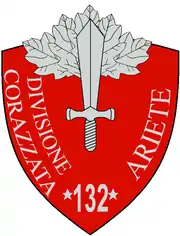 132a Armoured Division Ariete Insignia | |
| Active | 1 February 1939 – 8 December 1942 23 May 1948 – 30 September 1986 |
| Country | |
| Branch | Italian Army |
| Type | Armored |
| Size | Division |
| Garrison/HQ | Milan |
| Nickname(s) | Ariete (Ram) |
| Motto(s) | "Ferrea mole, Ferreo cuore" |
| Colors | blue and red |
| Mascot(s) | Ram Head |
| Engagements | Operation Compass Siege of Tobruk Operation Crusader Battle of Gazala First Battle of El Alamein Second Battle of El Alamein |
| Commanders | |
| Notable commanders | Raffaele Cadorna, Jr. Pietro Giannattasio Gian Marco Chiarini Roberto Ranucci Paolo Ruggiero |
World War II
France
The 132nd Armoured Division Ariete was formed in Milan in February 1939, it was initially made up of the 8th Bersaglieri Regiment, the 32nd Tank Infantry Regiment, equipped with L3/35 tankettes, the 132nd Armored Artillery Regiment, and additional divisional support units. The division was moved to the French border at the outbreak of World War II, but was kept in reserve during the short campaign on that front. It was part of the Army of the Po, the strategic reserve. By that time the 32nd Tank Infantry Regiment had grown to eight battalions: three light ones with L3/35 tankettes, two medium ones with M11/39 tanks, and three medium ones with M13/40 tanks.
Libya
In 1940 the I, II, III, and V medium battalions of the 32nd Tank Infantry Regiment were sent to Italian Libya piecemeal. The I and II medium tank battalions with M11/39 tanks were sent in summer and entered the Maletti Group, while the III and V medium tank battalions with M13/40 tanks arrived in October and November and entered the Special Armored Brigade (Brigata Corazzata Speciale, or BCS). Both the Maletti Group and the Special Armored Brigade were part of the ill-fated 10th Army.
Operation Compass
From December 1940 to February 1941, during Operation Compass, the British Western Desert Force overran the 10th Army and occupied Cyrenaica. The I battalion was destroyed in Egypt during the Attack on Nibeiwa, while the II battalion was lost in the fall of Tobruk. The III and V battalions were sacrificed during the failed break out attempt at the Battle of Beda Fomm. After this defeat it was decided to employ the whole Ariete Division in North Africa. On 24 January 1941, the first echelons of the division disembarked at Tripoli. From February 1941 to November 1942, the Ariete Division fought alongside the Deutsches Afrika Korps (DAK) in the North Africa Campaign. Initially the Ariete was attached to the Italian Mobile Corps (Corpo d'Armata di Manovra), which later became the Italian XX Motorised Corps.
Siege of Tobruk
In particular, reinforced in 1941 with the 132nd Tank Infantry Regiment, which would replace the 32nd Tank Infantry Regiment, (disbanded in mid-1942), the division took part in the first Axis counter-offensive to retake Cyrenaica, and the following siege of Tobruk. With the 132nd Tank Infantry Regiment, equipped with M13/40 and M14/41 tanks the division fought in the Western Desert of Libya and Egypt during 1941.
On 1 May 1941 the Germans and Italians attacked Tobruk in considerable strength. Their attack pierced the Australian defences; the Ariete and 8th Bersaglieri captured the R3, R4, R5, R6 and R7 strongpoints,[1] On 3 May the Australians launched a counter-attack with the 18th Brigade. The counter-attack only recaptured one strong point from what Australian historian Mark Johnston reported to be Italian defenders.[2] This action is later known as the Battle of the Salient.
During Operation Crusader, the division fought against the British 22nd Armoured Brigade at Bir el Gubi, inflicting heavy losses on the inexperienced British forces. On 23 November, the 15th Panzer Division moved on to attack the 5th South African Brigade defending Sidi Rezegh and that evening, Ariete with the 8th Bersaglieri Regiment, came up in support and the ridge was taken along with 3,400 prisoners.[3] During 29–30 November, the Ariete and supporting Italian infantry and motorcycle units were responsible for capturing a considerable number of New Zealand, Indian and British troops during the Italo-German counter-attacks. Recalling the loss of the 21st Battalion, Lieutenant-Colonel Howard Kippenberger, who later rose to command the 2nd New Zealand Division, wrote that,
About 5:30 p.m. damned Italian Motorized Division (Ariete) turned up. They passed with five tanks leading, twenty following, and a huge column of transport and guns, and rolled straight over our infantry on Point 175.[4]
When the battle led to the retreat of the Axis forces to the Gazala Line, the Ariete went on the attack, augmented by 23 tanks of the 15th Panzer Division and supported by Bersaglieri motorcycle troops, lost no time in assaulting the pursuing Commonwealth forces.[5] Between them, they overran the 1st Battalion, The Buffs (Royal East Kent Regiment) and part of the 5th Indian Brigade, taking according to one estimate 1,000 prisoners in the counter-attack.[6] The British were able to recover from this setback and the Ariete retreated through the Djebel Mountain towards el Agheila; by this time the division had lost almost all its tanks.
Reinforced again with replacement tanks and M40 75/18 mm semoventi assault guns in the V and VI battalions of the 132nd Artillery Regiment, it took part in the second counter-offensive of January 1942, the Gazala battles of May 1942 and the invasion of Egypt that followed.
Battle of Gazala
The Ariete met early success during the Battle of Gazala, when it overran the British-officered 3rd Indian Motor Brigade at Rugbet Al Atasc on 27 May 1942,[7] capturing 1,000 troops.[8] The Ariete then repelled strong British armoured counterattacks on 29 May and went on to repeat the same feat on 5 June 1942.[9]
El Alamein
During the initial phase of the First Battle of El Alamein the Ariete, which had just six or eight tanks and 1,000 men, having just arrived in the positions assigned to it at dawn on 3 July 1942 and due to the disorganization caused by enemy air attacks, had been compelled to withdraw after losing 531 men, several artillery batteries and a number of tanks. Rommel's report of the division having been decimated with the loss of 100 tanks was greatly exaggerated.[10][11]
During the Second Battle of El Alamein the Ariete sacrificed struggled to counter the Allied offensive and cover the withdrawal of the army. On 4 November at about 15:30, the few surviving tanks were surrounded by an overwhelmingly superior enemy, and general Arena, the division's commander, broadcast this message:[12]
"Enemy tanks broke through south of Ariete Division. Thus, Ariete surrounded, located 5 kilometers north-west of Bir-el-Abd. Ariete tanks are fighting."
— Ariete Division's last radio message[13]
Of three medium tank battalions, a Bersaglieri regiment, two artillery battalions and a self-propelled gun battalion that composed the division at the time, only the XIII Medium Tank battalion and 200 bersaglieri with 6 semoventi survived long enough to be destroyed along the coastal road or near Fuka on 5 and 6 November.[14] Rommel mourned the loss of the division, writing that its final action had been conducted with exemplary courage and that "in the Ariete we lost our oldest Italian comrades, from whom we had probably always demanded more than they, with their poor armament, had been capable of performing".[15]
135th Armoured Cavalry Division Ariete II
On 21 November 1942, the division was disbanded, and its name kept by a task force gathering up its remnants, which kept fighting throughout the retreat (including a notably successful rearguard action at El Agheila) and subsequent campaign in Tunisia. It was forced to surrender along with the rest of the Axis army in North Africa.
On 1 April 1943, as a tribute it was reconstituted as 135 Ariete II Armoured Cavalry Division, made up of cavalry regiments. The division was located in north eastern Italy, with the following order of battle;
- 135th Armoured Cavalry Division Ariete II, General Dardano Fenulli
- Armoured Reconnaissance Group "Lancieri di Montebello"[16]
- Command Squadron
- I Squadrons Group
- Command Squadron (4x AB.41)
- 1st Armored Car Squadron (17x AB.41)
- 2nd Armored Car Squadron (17x AB.41)
- 3rd Motorcycle Squadron
- II Squadrons Group
- Command Squadron (4x Semovente 47/32)
- 4th Motorcycle-machine gun Squadron
- 5th Semoventi Squadron (12x Semovente 75/18)
- 6th Semoventi Squadron (12x Semovente 47/32)
- III Squadrons Group
- Command Squadron
- 7th Anti-aircraft Squadron (12x 20/65 mod. 35 anti-aircraft cannons)
- 8th Ferrying Engineer Squadron (12x Assault boats)
- 10th Armoured Regiment "Lancieri di Vittorio Emanuele II"
- Command Squadron
- 3x Tank Squadron groups
- 3x Squadrons (10x Semovente 75/18 and 7x M15/42 tanks each)
- 16th Motorised Regiment "Cavalleggeri di Lucca"[17]
- Command Squadron
- Semoventi Squadron (12x Semoventi 75/18)
- Motorcycle Squadron (4x AB.41)
- 3x Squadron groups
- Command Squadron
- 2x Auto-transported squadrons
- Mortar Squadron (9x 81mm mortars)
- Support Weapons and Anti-aircraft Squadron (4x 20/65 mod. 35 anti-aircraft cannons, 4x Semoventi 75/18)
- Transport Unit
- 135th Armoured Artillery Regiment
- 235th Self-propelled Artillery Regiment[18]
- DCI Self-propelled Group (12x Semovente 105/25)
- DCII Self-propelled Group (12x Semovente 105/25)
- CXXXV Self-propelled Anti-tank Battalion (12x Semovente 75/34)
- X Recruits Training Group (12x M15/42 tanks)
- 135th Medical Section
- 135th Supply Section
- Armoured Reconnaissance Group "Lancieri di Montebello"[16]
It comprised the following armoured fighting vehicles:
- 42x AB.41
- 63x M15/42 tanks
- 16x Semovente 47/32
- 126x Semovente 75/18
- 12x Semovente 75/34
- 24x Semovente 105/25
for a total of 247 tank and semoventi plus 42 armoured cars.
The division was moved to central Italy following the fall of Benito Mussolini's government and took part to the defence of Rome from 9 to 10 September 1943, counter-attacking German Panzergrenadiers and Paratroopers. Because the Headquarters decided to avoid unnecessary sacrifices and losses, the division was ordered to surrender and was then disbanded.
Reconstitution
132nd Armored Division Ariete - 1952
On 23 May 1948 its reconstitution as a brigade sized unit begins at Forte Pietralata in Rome. The same year it was transferred to Pordenone in the Friuli region in Northern Italy. On 1 October 1952, the brigade had completed its increase to full division and commanded now the same regiments as during the African campaign:[19]
- 132nd Armored Division Ariete
 8th Bersaglieri Regiment
8th Bersaglieri Regiment
- III Bersaglieri Battalion with M3 Half-tracks
- V Bersaglieri Battalion with M3 Half-tracks
- XII Bersaglieri Battalion with M3 Half-tracks
- Bersaglieri Anti-tank Company with M40 recoilless rifles
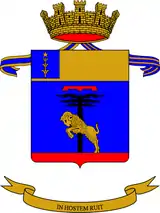 132nd Tank Regiment
132nd Tank Regiment
- I Tank Battalion with M26 Pershing
- II Tank Battalion with M26 Pershing
- III Tank Battalion with M26 Pershing
 132nd Armored Artillery Regiment
132nd Armored Artillery Regiment
- I Self-propelled Howitzer Group with M7 Priest
- II Self-propelled Howitzer Group with M7 Priest
- III Self-propelled Howitzer Group with M7 Priest
- IV Self-propelled Howitzer Group with M7 Priest
- V Light Air-defense Group with M1 40mm Automatic Guns
- VI Light Air-defense Group with M1 40mm Automatic Guns
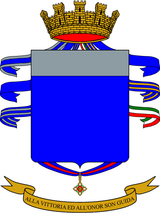 Armored Cavalry Squadron "Cavalleggeri Guide" with M8 Greyhound
Armored Cavalry Squadron "Cavalleggeri Guide" with M8 Greyhound- CXXXII Engineer Battalion
- 132nd Signal Company
Cold War
132nd Armored Division "Ariete" - 1963
In 1963 all Italian divisions adapted their organization to NATO standards and thus added a brigade level to the divisions structure. In the same year the reconstitution of the 32nd Tank Regiment began:
- I Mechanized Brigade "Ariete" (formed 1 January 1963 in Pordenone)
 8th Bersaglieri Regiment in Pordenone
8th Bersaglieri Regiment in Pordenone
- III Bersaglieri Battalion with M113
- XII Bersaglieri Battalion with M113
- VII Tank Battalion with M47 Patton
- Bersaglieri Anti-tank Company with M40 recoilless rifles
- I/132nd Armored Artillery Regiment with M7 Priest
- I Service Battalion
- 1st Engineer Company
- 1st Signal Company
- II Armored Brigade "Ariete" (1 October 1963 in Pordenone)
 32nd Tank Regiment in Cordenons (becomes operational 1 March 1964)
32nd Tank Regiment in Cordenons (becomes operational 1 March 1964)
- III Tank Battalion with M47 Patton
- V Tank Battalion with M47 Patton
- XXIII Bersaglieri Battalion with M113
- II/132nd Armored Artillery Regiment with M7 Priest
- II Service Battalion
- 2nd Engineer Company
- 2nd Signal Company
- III Armored Brigade "Ariete" (1 January 1963 in Maniago)
 132nd Tank Regiment in Aviano
132nd Tank Regiment in Aviano
- VIII Tank Battalion with M47 Patton
- X Tank Battalion with M47 Patton
- XXXVIII Bersaglieri Battalion with M113
- III/132nd Armored Artillery Regiment with M7 Priest
- III Service Battalion
- 3rd Engineer Company
- 3rd Signal Company
- "Ariete" Artillery Brigade (1 October 1963 in Casarsa della Delizia)
 132nd Armored Artillery Regiment in Pordenone
132nd Armored Artillery Regiment in Pordenone
- IV Heavy self-propelled Group with M44 howitzers
- V Heavy self-propelled Group with M110 howitzers (activates 16 February 1964)
- VI Light Air-defense Group with L60 40mm Automatic Guns (disbands 30 September 1964)
 XIX Reconnaissance Squadrons Group "Cavalleggeri Guide" with M24 Chaffee and M113
XIX Reconnaissance Squadrons Group "Cavalleggeri Guide" with M24 Chaffee and M113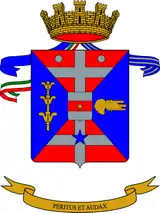 CXXXII Engineer Battalion
CXXXII Engineer Battalion- CCXXXII Signal Battalion
- "Ariete" Light Airplane Section with L-21B
- "Ariete" Helicopter Section with AB 47J helicopters
132nd Armored Division "Ariete" - 1974
On 1 October 1968 the brigade headquarters were disbanded and the divisions returned to its former structure. The "Ariete" Armored Division was part of the 5th Army Corps based in North-Eastern Italy. The 5th Army Corps was tasked with defending the Yugoslav-Italian border against possible attacks by either the Warsaw Pact, or Yugoslavia or both. The "Ariete" Armored Division was based in the corps' armored reserve.
Before the major reorganization of 1975 the division consisted of the following units:
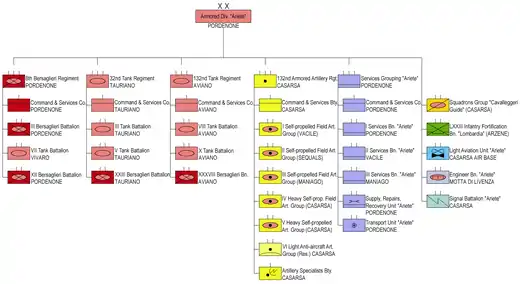
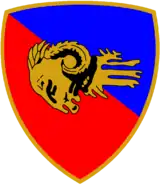 132nd Armoured Division Ariete|Armored Division "Ariete", in Pordenone
132nd Armoured Division Ariete|Armored Division "Ariete", in Pordenone
 8th Bersaglieri Regiment, in Pordenone[20]
8th Bersaglieri Regiment, in Pordenone[20]
- Command and Services Company, in Pordenone (includes an anti-tank guided missile platoon)
- III Bersaglieri Battalion, in Pordenone (M113 armored personnel carriers)
- VII Tank Battalion, in Vivaro (M60A1 Patton main battle tanks)
- XII Bersaglieri Battalion, in Pordenone (M113 armored personnel carriers)
 32nd Tank Regiment, in Tauriano[21]
32nd Tank Regiment, in Tauriano[21]
- Command and Services Company, in Tauriano (includes an anti-tank guided missile platoon)
- III Tank Battalion, in Tauriano (M60A1 Patton main battle tanks)
- V Tank Battalion, in Tauriano (M60A1 Patton main battle tanks)
- XXIII Bersaglieri Battalion, in Tauriano (M113 armored personnel carriers)
 132nd Tank Regiment, in Aviano[22]
132nd Tank Regiment, in Aviano[22]
- Command and Services Company, in Aviano (includes an anti-tank guided missile platoon)
- VIII Tank Battalion, in Aviano (M60A1 Patton main battle tanks)
- X Tank Battalion, in Aviano (M60A1 Patton main battle tanks)
- XXXVIII Bersaglieri Battalion, in Aviano (M113 armored personnel carriers)
 132nd Armored Artillery Regiment, in Casarsa della Delizia[23]
132nd Armored Artillery Regiment, in Casarsa della Delizia[23]
- Command and Services Battery, in Casarsa della Delizia
- I Self-propelled Field Artillery Group, in Vacile (M109G 155mm self-propelled howitzers)
- II Self-propelled Field Artillery Group, in Sequals (M109G 155mm self-propelled howitzers)
- III Self-propelled Field Artillery Group, in Maniago (M109G 155mm self-propelled howitzers)
- IV Heavy Self-propelled Field Artillery Group, in Casarsa della Delizia (M109G 155mm self-propelled howitzers)
- V Heavy Self-propelled Artillery Group, in Casarsa della Delizia (M55 203mm self-propelled howitzers)
- VI Light Anti-aircraft Artillery Group (Reserve), in Casarsa della Delizia (Bofors 40mm anti-aircraft guns and 12.7mm anti-aircraft machine guns)[24]
- Artillery Specialists Battery, in Casarsa della Delizia
- "Cavalleggeri Guide" Squadrons Group, in Casarsa della Delizia[25] (Fiat Campagnola reconnaissance vehicles and M47 Patton tanks)[26]
- LXXIII Infantry Fortification Battalion "Lombardia", in Arzene / Latisana[27]
- Light Aviation Unit "Ariete", at Casarsa Air Base[28] (L-19E Bird Dog light aircraft and AB 206 reconnaissance helicopters)
- Engineer Battalion "Ariete", in Motta di Livenza
- Signal Battalion "Ariete", in Casarsa della Delizia
- Services Grouping "Ariete", in Pordenone
- Command and Services Company, in Pordenone
- Supply, Repairs, Recovery Unit "Ariete", in Pordenone
- Transport Unit "Ariete", in Pordenone
- I Services Battalion "Ariete", in Pordenone
- II Services Battalion "Ariete", in Vacile
- III Services Battalion "Ariete", in Maniago
Armored Division "Ariete" - 1975
In 1975 the Italian Army undertook a major reorganization of it forces: the regiment level was abolished and battalions came under direct command of newly formed brigades, which combined units from different arms. Thus on 1 October 1975 the "Ariete" took command of the following brigades, which were formed from its disbanded regiments:
 Armored Division "Ariete", in Pordenone
Armored Division "Ariete", in Pordenone
 8th Mechanized Brigade "Garibaldi", in Pordenone (former 8th Bersaglieri Regiment)
8th Mechanized Brigade "Garibaldi", in Pordenone (former 8th Bersaglieri Regiment) 32nd Armored Brigade "Mameli", in Tauriano (former 32nd Tank Regiment)
32nd Armored Brigade "Mameli", in Tauriano (former 32nd Tank Regiment)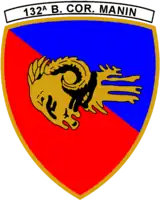 132nd Armored Brigade "Manin", in Aviano (former 132nd Tank Regiment)
132nd Armored Brigade "Manin", in Aviano (former 132nd Tank Regiment)
Additional troops were added to bring the division up to full strength:
- Command and Signals Battalion "Ariete", in Pordenone
 19th Cavalry Reconnaissance Squadrons Group "Cavalleggeri Guide", in Casarsa della Delizia, with Leopard 1A2 main battle tanks
19th Cavalry Reconnaissance Squadrons Group "Cavalleggeri Guide", in Casarsa della Delizia, with Leopard 1A2 main battle tanks.png.webp) 14th Bersaglieri (Training) Battalion "Sernaglia", in Albenga (former I Battalion, 89th Infantry (Training) Regiment "Salerno"; transferred from the Military Region North-West)
14th Bersaglieri (Training) Battalion "Sernaglia", in Albenga (former I Battalion, 89th Infantry (Training) Regiment "Salerno"; transferred from the Military Region North-West) 16th Infantry (Training) Battalion "Savona", in Legino (former II Battalion, 89th Infantry (Training) Regiment "Salerno"; transferred from the Military Region North-West)
16th Infantry (Training) Battalion "Savona", in Legino (former II Battalion, 89th Infantry (Training) Regiment "Salerno"; transferred from the Military Region North-West) 73rd Position Infantry Battalion "Lombardia", in Arzene (transferred from the 5th Army Corps)
73rd Position Infantry Battalion "Lombardia", in Arzene (transferred from the 5th Army Corps) 108th Heavy Self-propelled Field Artillery Group "Cosseria", in Casarsa della Delizia, with M109G 155mm self-propelled howitzers (former V Self-propelled Field Artillery Group, 132nd Armored Artillery Regiment; M109 replaced with FH70 155mm towed howitzers in 1981)
108th Heavy Self-propelled Field Artillery Group "Cosseria", in Casarsa della Delizia, with M109G 155mm self-propelled howitzers (former V Self-propelled Field Artillery Group, 132nd Armored Artillery Regiment; M109 replaced with FH70 155mm towed howitzers in 1981) 132nd Heavy Self-propelled Field Artillery Group "Rovereto", in Casarsa della Delizia, with M109G 155mm self-propelled howitzers (former IV Self-propelled Field Artillery Group, 132nd Armored Artillery Regiment; M109 replaced with FH70 155mm towed howitzers in 1981)
132nd Heavy Self-propelled Field Artillery Group "Rovereto", in Casarsa della Delizia, with M109G 155mm self-propelled howitzers (former IV Self-propelled Field Artillery Group, 132nd Armored Artillery Regiment; M109 replaced with FH70 155mm towed howitzers in 1981) 132nd Engineer Battalion "Livenza", in Motta di Livenza
132nd Engineer Battalion "Livenza", in Motta di Livenza 232nd Signal Battalion "Fadalto", in Casarsa della Delizia
232nd Signal Battalion "Fadalto", in Casarsa della Delizia- "Ariete" Artillery Specialist Group, in Casarsa della Delizia, (Counter-battery radars and drones) (merged Command and Services, and Artillery Specialists batteries of the 132nd Armored Artillery Regiment)
- 49th Reconnaissance Helicopter Squadrons Group "Capricorno", in Casarsa della Delizia
 Logistic Maneuver Battalion "Ariete", in Casarsa della Delizia
Logistic Maneuver Battalion "Ariete", in Casarsa della Delizia- Medical (Reserve) Battalion "Ariete", in Casarsa della Delizia
When the Italian Army abolished the divisional level on 10 October 1986 the 132nd Armored Brigade "Manin" was renamed as 132nd Armored Brigade "Ariete".
Citations
- Rommel's Army in Africa, Dal McGuirk, p. 91, Stanley Paul, 1987 and XXXII BATTAGLIONE GUASTATORI
- That magnificent 9th: An Illustrated History of The 9th Australian Division, Mark Johnston, p. 38, Allen and Unwin, 2002
- Rommel's Desert Commanders: The Men Who Served The Desert Fox, North Africa, 1941–1942, Samuel W. Mitcham, p.50, Praeger, 2007
- Infantry Brigadier, Howard Kippenberger, p. 101, Oxford University Press, 1949, (371 pages)
- "Italians passed to counter-attack along the whole line (The Bologna Division: 19 November – 10 December, 1941) By David Aldea & Joseph Peluso, Comando Supremo: Italy at War". Archived from the original on 5 June 2011. Retrieved 11 June 2011.
- Das Afrika Korps: Erwin Rommel and the Germans in Africa, 1941–43, By Franz Kurowski, p. 125, Stackpole Books (March 2010)
- James J. Sadkovich, Of Myths ad Men: Rommel and the Italians in North Africa, p. 302, The International History Review XIII (1991)
- Das Afrika Korps: Erwin Rommel and the Germans in Africa, 1941–43, By Franz Kurowski, pg. 125, Stackpole Books (March 1991)
- James J. Sadkovich, Of Myths ad Men: Rommel and the Italians in North Africa, p. 303, The International History Review XIII (1991)
- "Under a Fading Moon, (First Battle of El Alamein), David Aldea, Comando Supremo, Italy at War". Archived from the original on 19 June 2011. Retrieved 23 June 2011.
- Rommel's North Africa Campaign: September 1940-november 1942, Jack Greene, Alessandro Massignani, p. 196, Da Capo Press, Revised Edition, (272 pages)
- Rommel's Desert War: The Life and Death of the Afrika Korps, Samuel W. Mitcham, p. 176, Stackpole Books, 2000
- Rommel's Desert War: The Life and Death of the Afrika Korps, Samuel W. Mitcham, p. 176, Stackpole Books, 2000
- Caruso, Alfio (2011). L'onore d'Italia. Milan: Longanesi.
- The Rommel Papers, p. 325
- "Reggimento "Lancieri di Montebello" 8°". Regio Esercito. Retrieved 26 November 2019.
- "Reggimento "Cavalleggeri di Lucca" 16°". Regio Esercito. Retrieved 26 November 2019.
- Finazzer, Enrico. Le Artiglierie del Regio Esercito nella seconda guerra mondiale. Soldiershop. p. 146. ISBN 8893272156.
- http://www.esercito.difesa.it/Organizzazione/Organizzazione%20Centrale/Comando%20delle%20Forze%20Operative%20Terrestri/1_fod/br_corazzata_ariete/Pagine/la_storia.aspx Italian Army homepage; History of the Ariete Brigade
- F. dell'Uomo, R. Puletti (1998). L'Esercito Italiano verso il 2000 - Vol. Primo - Tomo I. Rome: SME - Ufficio Storico. p. 429.
- F. dell'Uomo, R. Puletti (1998). L'Esercito Italiano verso il 2000 - Vol. Primo - Tomo I. Rome: SME - Ufficio Storico. p. 543.
- F. dell'Uomo, R. Puletti (1998). L'Esercito Italiano verso il 2000 - Vol. Primo - Tomo I. Rome: SME - Ufficio Storico. p. 553.
- F. dell'Uomo, R. Puletti (1998). L'Esercito Italiano verso il 2000 - Vol. Primo - Tomo II. Rome: SME - Ufficio Storico. p. 176.
- Stefani, Filippo (1985). La storia della dottrina e degli ordinamenti dell'Esercito Italiano. Rome: Ufficio Storico - Stato Maggiore Esercito. p. Volume III, Tomo 2, pages 473–483.
- F. dell'Uomo, R. Puletti (1998). L'Esercito Italiano verso il 2000 - Vol. Primo - Tomo II. Rome: SME - Ufficio Storico. p. 70.
- Stefani, Filippo (1985). La storia della dottrina e degli ordinamenti dell'Esercito Italiano. Rome: Ufficio Storico - Stato Maggiore Esercito. p. Volume III, Tomo 2, page 437.
- F. dell'Uomo, R. di Rosa (2001). L'Esercito Italiano verso il 2000 - Vol. Secondo - Tomo I. Rome: SME - Ufficio Storico. p. 236.
- Cerbo, Giovanni (1996). L'Aviazione dell'Esercito - Dalle origini ai giorni nostri. Rome: Rivista Militare. p. 76. Retrieved 28 November 2018.
References
- Ian W. Walker, Iron Hulls, Iron Hearts; Mussolini's Elite Armoured Divisions in North Africa, 2006 ISBN 1-86126-646-4